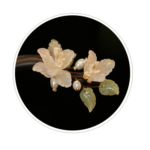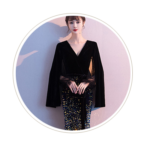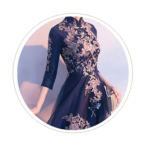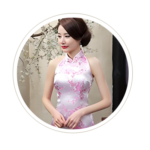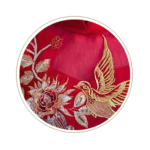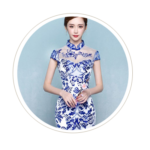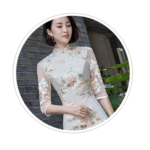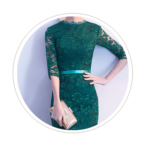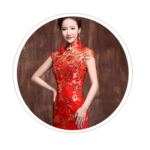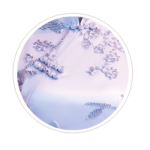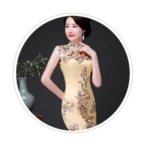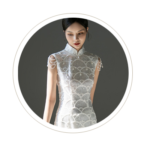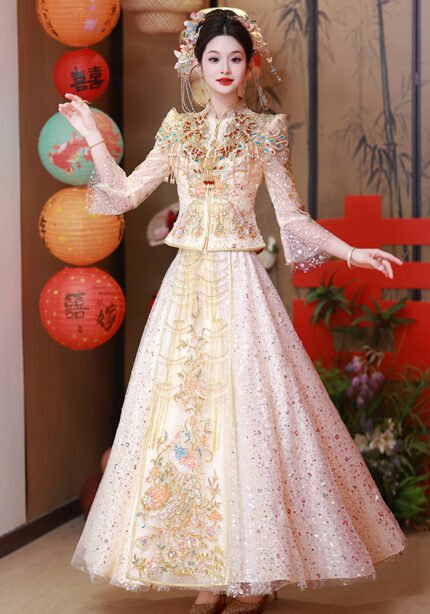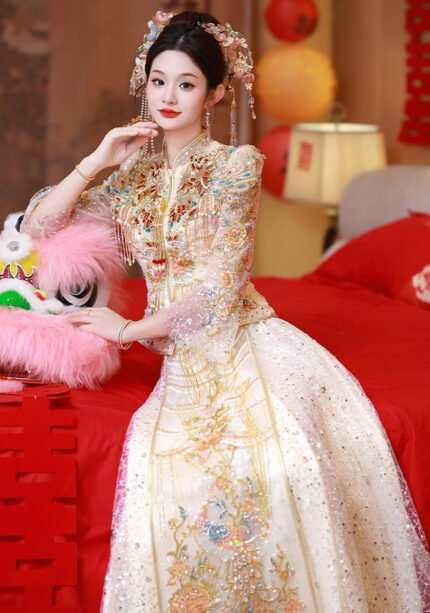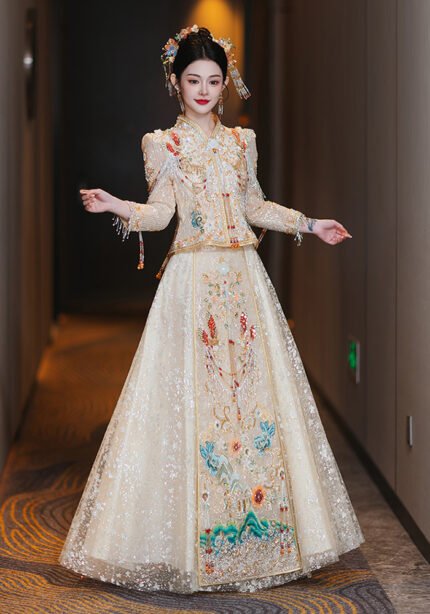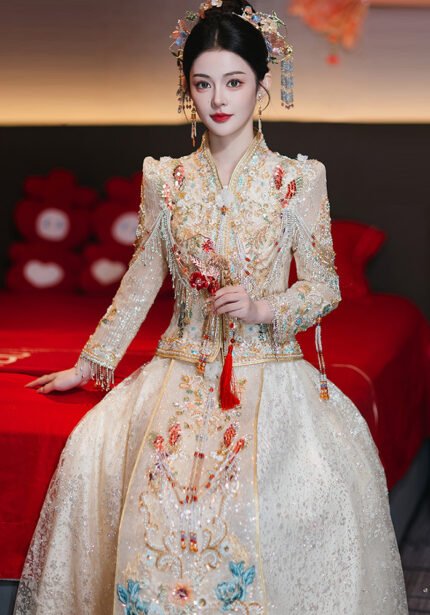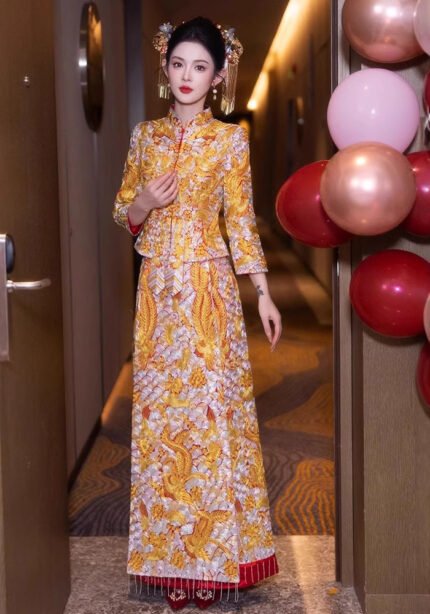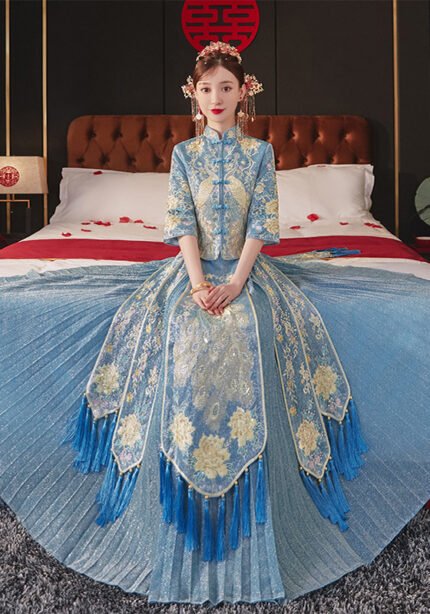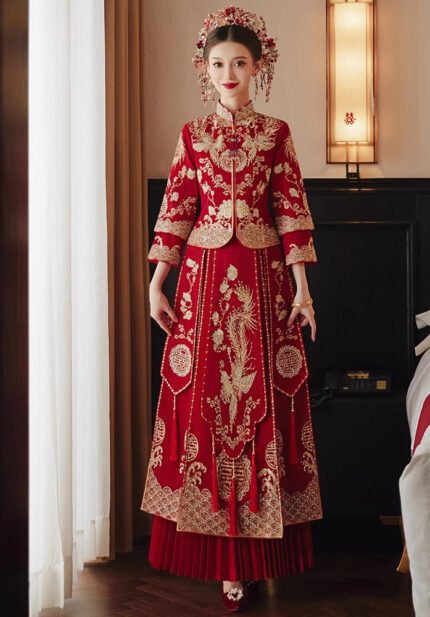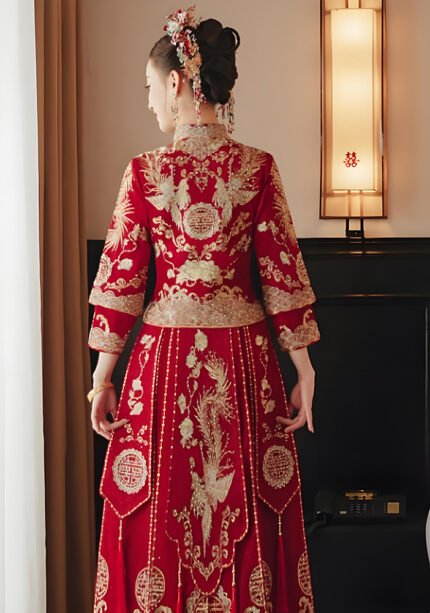Qun Kwa Wedding Dress Features:
1. Intricate Embroidery: Features elaborate and colorful embroidery, often depicting traditional motifs like flowers and auspicious patterns, showcasing superb craftsmanship.
2. Glamorous Fabric: Made of glittery materials that give off a brilliant sheen, adding a touch of luxury and making the wearer eye-catching.
3. Traditional-Modern Fusion: Blends classic Chinese design elements with contemporary tailoring. The upper jacket and flowing skirt combination offers both a nod to tradition and a modern-day comfortable fit.
4. Graceful Silhouette: Creates an elegant and feminine shape, with a fitted bodice and a flared skirt that enhances the overall gracefulness.
5. Complete Ensemble: Often comes with matching headpieces and accessories, forming a harmonious and refined traditional bridal or ceremonial look.
Traditional Qun Kua styles feature a short jacket with a symmetrical or diagonal closure paired with a horse-face skirt or a modernized long skirt. The embroidery often incorporates auspicious motifs such as dragons, phoenixes, floral and avian designs, and the character “Fu” (symbolizing blessings).
Qun Kwa(Kua) Dress
Introduction to Qun Kwa Wedding Dress The Timeless Elegance of Traditional Chinese Wedding Attire
I. Origins & History
The emerged during the late Qing Dynasty and early Republic of China, becoming a quintessential bridal garment in Chinese weddings. Its name was popularized by the character "Xiuhе" (played by Zhou Xun) in the TV drama Juzi Hongle (Orange Is Red), whose iconic attire became synonymous with this style. Blending Manchu qipao elements with Han Chinese bridal traditions, the Xiuhеfu symbolizes blessings of "eternal harmony" and "auspicious fortune," embodying the cultural essence of Chinese matrimonial ceremonies.
II. Design & Features
1. Classic Elements
- Silhouette: A short, stand-collar jacket (with symmetrical or diagonal closures) paired with a horse-face skirt (ma mian qun) or pleated skirt, exuding grace and dignity.
- Embroidery: Intricate motifs like dragons, phoenixes, peonies, mandarin ducks, and clouds, crafted with gold/silver threads or raised embroidery (panjinxiu), signify prosperity and good fortune.
- Color: Traditional vibrant red represents joy; modern variations include champagne gold, blush pink, and other pastels for contemporary tastes.
2. Modern Adaptations
- Lightweight Designs: Simplified embroidery and breathable fabrics enhance comfort.
- Fusion Styles: Incorporate Western veils, lace accents, or tailored silhouettes (e.g., fitted waists, trains) for a blend of East-meets-West aesthetics.
III. Occasions to Wear
- Traditional Weddings: Ideal for tea ceremonies, vow exchanges, or ancestral rituals.
- Western Weddings: Adds cultural flair to receptions or cocktail hours.
- Special Events: Perfect for anniversary photoshoots, Lunar New Year celebrations, or cultural festivals.
IV. Styling Tips
1. Hair & Accessories
- Classic Updos: Pair with phoenix crowns (feng guan), tasseled hairpins (buyao), or jeweled combs.
- Minimalist Looks: Low buns with pearl hairpins complement modern Xiuhеfu designs.
2. Accessories
- Hand Fans: Embroidered or silk tapestry (kesi) round fans add tradition.
- Footwear: Red embroidered slippers for authenticity, or metallic heels for a modern twist.
V. Buying & Care Guide
1. Purchasing Tips
- Fit: Prioritize mobility; avoid overly stiff embroidery.
- Craftsmanship: Hand-embroidered pieces are luxurious, while machine-made options offer affordability.
- Rent vs. Customize: Renting suits one-time use; custom-made garments become heirlooms.
2. Maintenance
- Dry clean only to preserve delicate embroidery.
- Store the hung in a cool, dry place, protected from moths and humidity.
VI. Cultural Significance
More than a bridal gown, the Xiuhеfu carries familial heritage and cultural pride. With the rise of "Guochao" (China-chic), it has become a symbol of cultural confidence among younger generations, even gracing international runways to showcase the allure of Eastern aesthetics.
Final Note
Whether in classic crimson or modern pastels, the Qun Kwa captures a bride’s elegance and poise. For those planning a culturally rich wedding or seeking to embrace tradition, this exquisite attire promises to elevate your celebration with timeless charm!


